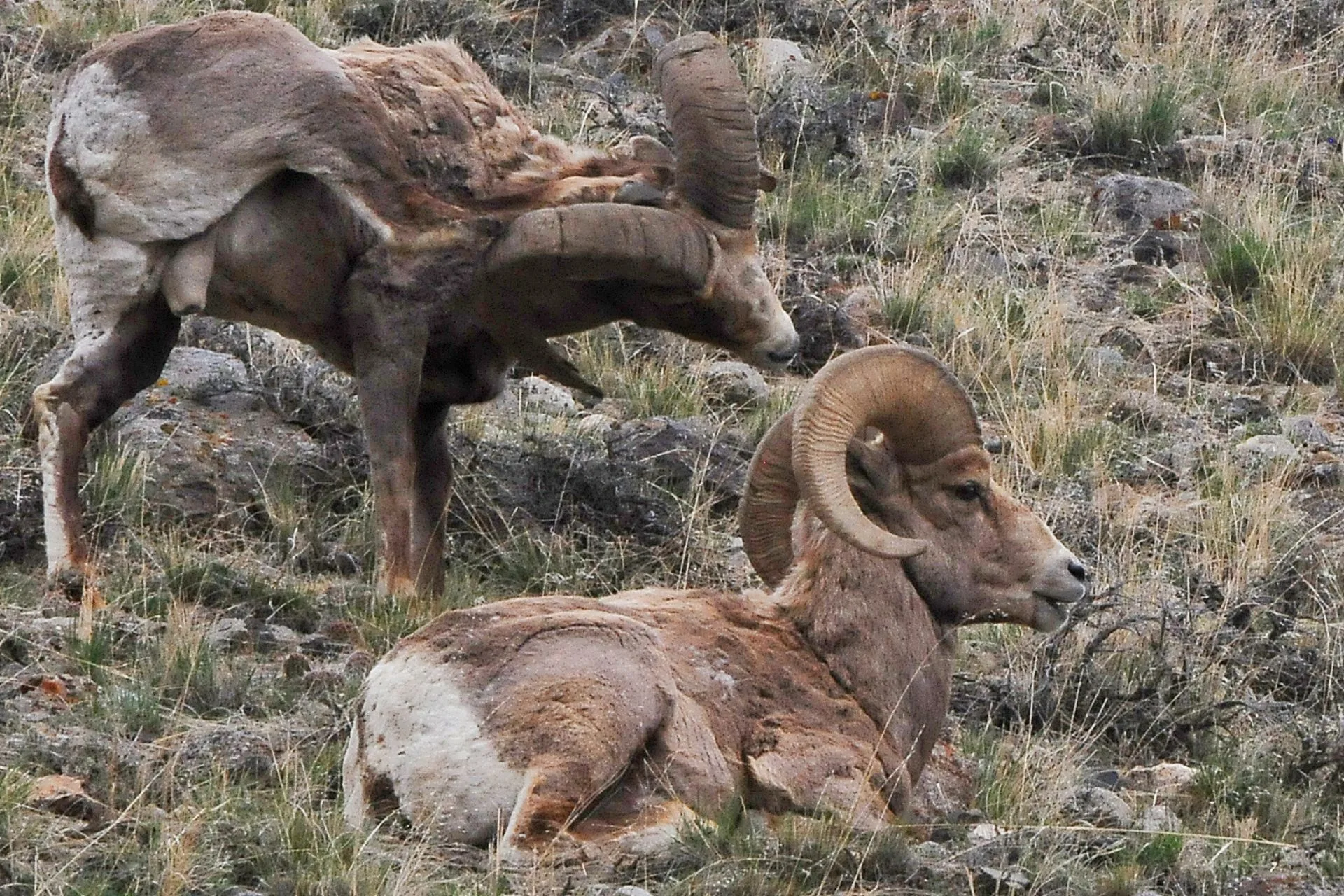Brett French photo | Numerous studies conducted in Montana are attempting to understand bighorn sheep’s susceptibility to disease and die-off events.
BRETT FRENCH | bfrench@billingsgazette.com
In 1980, a band of bighorn sheep were captured from the Sun River area along the Rocky Mountain Front and moved to a foreign landscape to the east, north of Montana’s massive Fort Peck Reservoir.
The mixed grass prairie and badland environment of the C.M. Russell National Wildlife Refuge surrounding the reservoir was a new, but also ancient, location for the animals — an area in which their ancestors once thrived until being wiped out in the early 20th century by a “combination of livestock competition, habitat loss, disease, and unregulated hunting,” according to Montana Fish, Wildlife & Parks’ 2010 publication “Montana Bighorn Sheep Conservation Strategy.”
Now there’s a concern that history is repeating itself in this region of the Missouri River Breaks.
This year, FWP biologists located only five animals in Hunting District 622, one of which died while being observed and was retrieved for a necropsy. FWP has not yet released results.
In light of the severe population decline, the Fish and Wildlife Commission decided in an emergency March meeting to close HD 622 to all bighorn sheep hunting.
Cause of die-off still unknown
What caused the once thriving band of bighorn sheep to vanish?
“This is a puzzle,” said Scott Thompson, Region 6 wildlife manager for FWP. “Something has changed here and we’re not sure what it is.”
The puzzle needs to be solved before FWP moves to transplant any more sheep into the area, he added.
Disease, drought and predators like mountain lions have all been blamed for the herd’s demise. Unfortunately, large die-offs are not an unusual occurrence for bighorn sheep in Montana. Other herds have boomed and then went bust. Some barely trickle along at low populations unable to rebuild.
Scientists have searched for answers, capturing and collaring wild sheep to track their movements, taking blood and nose swabs for laboratory analysis.
Change in thinking
Years ago, mingling with domestic sheep was often blamed for bighorn die-offs. The livestock carry pathogens the bighorns were susceptible to, potentially leading to pneumonia outbreaks that could wipe out entire herds.
Keep domestic and wild sheep separate, wildlife experts postulated, and the bighorns should be OK. One outcome of this philosophy is that wandering bighorn rams, an animal for which it is hard for hunters to draw a tag to kill, were shot by wildlife officials out of fear the animal might spread disease, including two rams from the HD 622 herd a decade ago.
“I talked with most of the domestic producers in lower 622,” wrote Brent Roeder, a Montana State University Extension sheep specialist, in an email. “They say they have never seen a wild sheep next to their domestics.”
One of the larger producers in the area sold out this winter as coyotes cut production, Roeder said. That leaves only two sheep producers in the region, one of which is farther to the west.
Roeder is part of a research team at MSU that has received $4 million in funding to “help lay the groundwork for disease prevention and management of wild and domestic sheep around the state and region,” according to a 2024 MSU press release.
In addition to assessing how often bighorns and domestic sheep interact, the study is aimed at finding “adaptive management strategies to allow both species to exist … and to help understand how diseases spread among populations.”
Other research has looked at different causes for bighorn sheep declines. Studies showed herds may carry the same pathogens, but one collapses while the other seems immune. Something else had to be triggering the response, scientists speculated. Could it be nutrition related?
“The nutritional status of these animals is a critical determinant of their survival, reproduction, and overall population dynamics,” a study published by MSU researchers this year noted. “Enhancing our understanding of their metabolic responses to nutritional stress is essential.”
The study took samples from 388 wild bighorn sheep in Montana and Wyoming collected between 2014 and 2017 from December through March in an attempt to identify “characteristic metabolic patterns and metabolic interactions between early and severe” states of poor nutrition.
“This research strengthens our understanding of metabolic adaptations to environmental stressors in wild ruminants, offering a foundation for improving management practices to maintain healthy bighorn sheep populations,” the researchers wrote.
Bighorns carry lots of pathogens
In 2022, FWP published its findings from a six-year study of 14 bighorn herds, taking samples from more than 500 animals to establish their “baseline health status.”
At the root of the study was the recognition that “respiratory disease has been identified as one of the largest and most damaging health issues facing bighorn sheep,” not just in Montana, but across the West, resulting in “pronounced effects on bighorn sheep populations.”
Twenty-five outbreaks of respiratory disease have been documented in Montana since 1979.
Yet the researchers found no exposure of the HD 622 herd to the main respiratory bug — Mycoplasma ovipneumoniae.
What they found, however, was plenty of scary sounding pathogens, including: Mannheimia haemolytica/glucosida, Mannheimia species/ruminalis, non-hemolytic Bibersteinia trehalose and contagious ecthyma.
The bighorns also carried parasites like coccidia and Protostrongylus lungworms.
They’d also been exposed to epizootic hemorrhagic disease virus, which is transmitted by biting midges, as well as bovine respiratory syncytial virus.
Despite the presence of all these infectious agents, only four years ago FWP researchers identified the Middle Missouri Breaks herd as “among our most robust populations, with no history of respiratory disease and consistently good body condition.”
Prairies hold possibilities
A study published in 2020 led by Jesse DeVoe, who went on to become an FWP researcher, hailed Montana’s prairie habitat as the next best place for establishing new bighorn sheep populations. At the time bighorns were occupying less than 6% of their historical range in Eastern Montana.
The Middle Missouri Breaks seemed one of the best areas for transplants, seeing as more than 80% of the land is under federal ownership by the Bureau of Land Management or U.S. Fish and Wildlife Service.
Initially, bighorn sheep populations north and south of the Missouri River were doing so well that they were the source for seven transplant operations that moved nearly 150 sheep to other herds.
When the Middle Missouri Breaks animals were first transplanted in 1980, half of the sheep almost immediately lit out 13 miles farther east into the Iron Stake Ridge/Larb Hills area, FWP reported. Once on the go, they even expanded farther east to the Bone Trail region.
The other half of the transplants decided to stick around and explore where they’d been dropped off, occupying the Mickey and Brandon Buttes area, according to a 2022 Montana Fish, Wildlife & Parks report. The remote terrain is located between Fourchette Bay and the UL Bend National Wildlife Refuge.
“In 1986, a total of 90 sheep were observed during ground surveys, and a limited license hunting season was instituted for these two fairly distinct herds,” according to FWP.
By 2008 the bighorn population in the hunting district had grown to 202 animals in a hunting district that is spread across about 116 square miles.
Habitat concerns raised early
Despite this early success, by 2010 FWP biologists were concerned about limited habitat and disease in the Mickey-Brandon buttes area herd.
“Sheep habitat in this hunting district is more limited and of lower quality when compared to other Missouri River Breaks bighorn sheep hunting districts and thus supports lower population densities of bighorns.”
The smaller herd averaged 50 animals between 1986 and 2010, peaking at 80 bighorns in the mid-1990s before falling to only six animals by 2016. Then the herd vanished.
“Between 1997 and 2001, lamb and ewe numbers dropped to less than half of previous levels in the Mickey-Brandon buttes subpopulation,” FWP noted. “Although no sick or dead animals were found, this decrease is believed to have been disease and nutrition related and was largely the result of very poor reproduction for a period of 5 years.”
Meanwhile the bigger herd grew to a high of 318 sheep by 2016, large enough that 20 animals were captured and relocated to boost a different herd’s population in northwestern Montana.
“We were pretty aggressive managing sheep numbers to objective there,” Thomson, the FWP wildlife manager noted.
By 2016, 73 tags were issued to hunters in the district with 70 animals killed, 10 of them rams. By last season that had fallen to nine hunters who shot six bighorns, five of them rams.
“We’ve had our eye on that region for over a year encouraging (FWP to take) a deeper dive” into the declining population, said Ty Stubblefield, executive director of the Montana Wild Sheep Foundation. “We’ve gone from being the tag everyone wanted to buy to being third or fourth fiddle.”
“There are now 45 populations of bighorns across Montana with 36 sustaining limited hunting,” according to FWP. “Officials estimate that 5,700 bighorn sheep inhabit Montana, excluding Yellowstone and Glacier national parks.”
Unfortunately, many of these herds are small and isolated.




